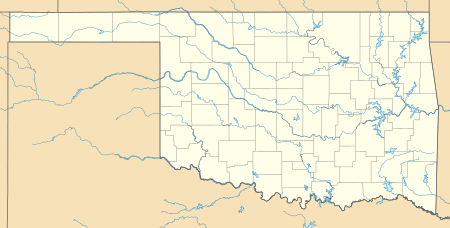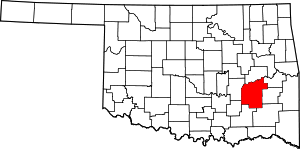Pittsburg, Oklahoma
Pittsburg is a town in Pittsburg County, Oklahoma, United States. The population was 280 at the 2000 census.
Pittsburg, Oklahoma | |
|---|---|
 Pittsburg, Oklahoma Location within the state of Oklahoma | |
| Coordinates: 34°42′46″N 95°51′4″W | |
| Country | United States |
| State | Oklahoma |
| County | Pittsburg |
| Area | |
| • Total | 0.47 sq mi (1.22 km2) |
| • Land | 0.47 sq mi (1.22 km2) |
| • Water | 0.00 sq mi (0.00 km2) |
| Elevation | 764 ft (233 m) |
| Population (2010) | |
| • Total | 207 |
| • Estimate (2019)[2] | 197 |
| • Density | 419.15/sq mi (161.91/km2) |
| Time zone | UTC-6 (Central (CST)) |
| • Summer (DST) | UTC-5 (CDT) |
| ZIP code | 74560 |
| Area code(s) | 539/918 |
| FIPS code | 40-59350[3] |
| GNIS feature ID | 1096696[4] |
History
Pittsburg has been known by more than one name. A post office was established under the name Cowper on April 2, 1903.[5] Its name was changed to Edwards, Indian Territory on September 3, 1903, and again to Pittsburg, Oklahoma on August 27, 1909. During its time as Edwards it was named for J.R. Edwards, a coal operator. Its newest name, Pittsburg, commemorates the county which was created at Oklahoma's statehood in 1907.[6]
At the time of its founding, the community was located in the Moshulatubbee District of the Choctaw Nation. The town was in the area of the boundary between Atoka County and Tobucksy County, and differing maps of the era placed it in each.[7]
Geography
Pittsburg is located at 34°42′46″N 95°51′4″W (34.712769, -95.850993).[8] According to the United States Census Bureau, the town has a total area of 0.5 square miles (1.3 km2), all of it land.
Demographics
| Historical population | |||
|---|---|---|---|
| Census | Pop. | %± | |
| 1920 | 892 | — | |
| 1930 | 873 | −2.1% | |
| 1940 | 689 | −21.1% | |
| 1950 | 278 | −59.7% | |
| 1960 | 195 | −29.9% | |
| 1970 | 282 | 44.6% | |
| 1980 | 305 | 8.2% | |
| 1990 | 249 | −18.4% | |
| 2000 | 280 | 12.4% | |
| 2010 | 207 | −26.1% | |
| Est. 2019 | 197 | [2] | −4.8% |
| U.S. Decennial Census[9] | |||
As of the census[3] of 2000, there were 280 The population density was 582.1 people per square mile (225.2/km2). There were 121 housing units at an average density of 251.6 per square mile (97.3/km2). The racial makeup of the town was 67.50% White, 22.14% Native American, 0.36% from other races, and 10.00% from two or more races. Hispanic or Latino of any race were 2.14% of the population.
There were 107 households, out of which 31.8% had children under the age of 18 living with them, 55.1% were married couples living together, 17.8% had a female householder with no husband present, and 20.6% were non-families. 19.6% of all households were made up of individuals, and 12.1% had someone living alone who was 65 years of age or older. The average household size was 2.62 and the average family size was 2.96.
In the town, the population was spread out, with 25.7% under the age of 18, 9.6% from 18 to 24, 26.4% from 25 to 44, 23.9% from 45 to 64, and 14.3% who were 65 years of age or older. The median age was 38 years. For every 100 females, there were 87.9 males. For every 100 females age 18 and over, there were 96.2 males.
The median income for a household in the town was $19,479, and the median income for a family was $22,250. Males had a median income of $25,833 versus $17,500 for females. The per capita income for the town was $10,258. About 15.5% of families and 21.7% of the population were below the poverty line, including 30.8% of those under the age of eighteen and 12.2% of those 65 or over.
References
- "2019 U.S. Gazetteer Files". United States Census Bureau. Retrieved July 28, 2020.
- "Population and Housing Unit Estimates". United States Census Bureau. May 24, 2020. Retrieved May 27, 2020.
- "U.S. Census website". United States Census Bureau. Retrieved 2008-01-31.
- "US Board on Geographic Names". United States Geological Survey. 2007-10-25. Retrieved 2008-01-31.
- "Postmasters by City: Pittsburg Post Office". United States Postal Service. Retrieved July 29, 2020.
- Shirk, George H. Oklahoma Place Names (Norman: University of Oklahoma Press, 1965), pp. 70 & 167.
- Morris, John W. Historical Atlas of Oklahoma (Norman: University of Oklahoma Press, 1986), plate 38.
- "US Gazetteer files: 2010, 2000, and 1990". United States Census Bureau. 2011-02-12. Retrieved 2011-04-23.
- "Census of Population and Housing". Census.gov. Retrieved June 4, 2015.
